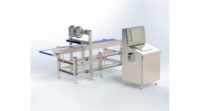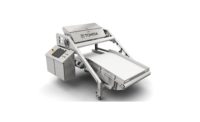
|
After all, it’s hard to show a return on investment for this equipment, because quality control is a defensive method. However, most retailers and food-safety plans require processors to use inspection systems to prove their product is free of metal, plastic, bone and other foreign materials. And fortunately, these systems keep evolving to accommodate the sensitive nature of the fresh products — and their changing labor force.
In short, metal detectors are still traditionally more economical compared to X-ray systems in terms of initial investment and ongoing system costs. They excel at detecting nonferrous metals and seem to be better understood by plant personnel. On the other hand, X-ray systems can better locate non-metal materials such as plastic, bone and glass.
“The systems have gotten much better at capturing smaller particles, but they are not a silver bullet, so plants still need proper production processes in place,” says Gary McMurray, chief of the Food Processing Technology Division at the Atlanta-based Georgia Tech Research Institute.
Preventing false alarms
With any foreign-material inspection device, sensitivity capability is a consideration.
We can all agree that a fresh-meat product has more conductivity than, say, a dry-goods product such as cereal. So when fresh product goes through metal-detection systems, for example, these systems have to be set at a more sensitive setting to accommodate the conductivity of these items.
Today, some suppliers are installing new software that allows for a more accurate reading of these products without setting off unnecessary alarms.
Since detectors are pushed for high sensitivity, vibrations in the line — which are inherent for the inspection process — can also trigger false alarms. Now, software is being designed to eliminate the consequences of vibrations in the system, without losing its sensitivity, as well.
In addition, since processors have expressed more interest today in performance validation, metal-detection systems, at least, are being built with software that reminds employees to test the accuracy of the machine.
So, for example, every two to four hours an employee may be required to test the metal detector by running metal particles through the system to see if they trigger an alarm. To remind employees to run this test, software now sounds a warning (usually a light or horn alarm) or reminder if the test isn’t conducted — ultimately leading to the machine shutting down if the test isn’t performed.
With the implementation of the Food Safety Modernization Act, processors also are looking for more data collection and reporting capabilities from their system’s software. Access logs are available that would identify who has logged into the system — and when — with a time and date stamp. Personnel could retrieve this data easily through an optional USB port and simply download the reports.
Keeping throughput steady
Challenges still remain, however, with matching throughput during the inspection process to production rates, says McMurray, which is a costly expense.
“Also, how do you capture a defective product?” asks McMurray. “Ideally, you would want to reject one breast fillet, so the amount of product taken off and reintroduced to the line is at a minimum.”
Instead, if a sensor goes off, 30 to 40 pounds of poultry could be taken off the line. Plant employees would then sort through the product to find the faulty breast. Once the threat was found, the other products would then be reintroduced to the line. All the while, throughput would be slowed down.
“The X-ray power is cranked up so nothing is missed, but then plants get a lot of false alarms,” says McMurray.






Report Abusive Comment